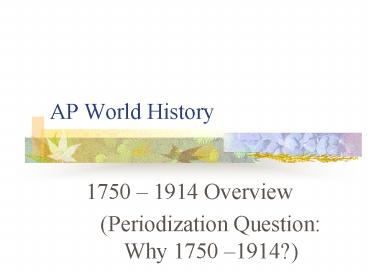AP World History PowerPoint PPT Presentation
1 / 30
Title: AP World History
1
AP World History
- 1750 1914 Overview
- (Periodization Question Why 1750 1914?)
2
Industrialization changed Production
- Britain was the center (geography, distribution
of coal and iron, demographic changes/urbanization
, B. entrepreneurialism access to foreign
resources through colonialism, capitalism) - Factories and fossil fuel-based machines
- Colonialism search for raw materials markets
new patterns of trade, capitalism and New
Imperialism (China, India) - IR contributed to decline of agriculturally-based
economies - Mining imp gold/silver/diamonds (S. Africa,)
3
Changes in Global Commerce, Communication and
Technology
- Modes of Transportation/ communication
- Impact of railroad, steam, telegraph
- Suez Canal, Panama Canal
4
Changes in Global Commerce, Communication and
Technology
- Industrial Revolution Financial Institutions,
Responses - Rationale of capitalism Adam Smith,
laissez-faire - Stock market expansion, transnational businesses
- Impact of I.R. on family and work
- Relationship of nations during I.R.
- Have/have-nots, nation response (Egypt,China
vs. Japan, Meiji reforms) - Intellectual responses to I.R. Marxism,
- socialism, utopianism, unions - govts create
state pensions, suffrage, education
5
Power loom
Fatcat
Milltown
Miner
Streetchildren
6
Demographic/Environmental Changes
- Migration Immigration
- Why?
- Where?
- Global Urbanization
- Women take new rolesMigrant Males (labor)
- Prejudice, racism laws(Chinese Exclusion Act)
- New transplant culture think IS DBQ, Chinese
railroads, convict labor in Australia
7
Demographic and Environmental Changes
- End of Atlantic Slave Trade capitalism and
Indentured servitude, voluntary migration - New Birthrate Patterns
- Disease prevention
- and eradication
- Food Supply
- Population RISES
8
Changes in Social and Gender Structure
- Industrial Revolution women working and then
VICTORIAN ERA at home - Commercial developments
- Tension between work patterns and ideas about
gender - Emancipation of Serfs
- Slaves
- Suffrage
9
Changes in Social and Gender Structure
- Womens emancipation movements
10
European women 19th century
Queen Victorias family
British family in India
Russian peasant family
11
Nationalism, Revolution, Reform
- Enlightenment thought political individual
rights freedoms (Voltaire, Rousseau, Locke,
Montesquieu) REVOLUTIONS! - New documents (Declaration of Independence,
Declaration of Rights of Man) - Abolition of slavery, expanded suffrage
- Development of nationalism (language, religion,
culture, tdentiity byt erritory) - Revolutions in Americas led to New Imperialism
- Anti-colonial movements (Boxer Rebellion) led to
reforms (Tanzimat, Self-strengthening movements)
and new ideologies (socialism, communism) - Europeans self-superiority conservatism, new
imperialism, social darwinism - Womens Rights (Seneca Falls, Declaration of the
Rights of Women, Wollstonecraft)
12
Political Revolutions and Independence Movements
- Revolutions
- Why Revolution now?
- Where?
- United States (1776)
- France (1789)
- Haiti (1803)
- Mexico (1910)
- China (1911)
13
Political Revolutions and Independence Movements
- Latin American Independence Movements
- Why?
Simon Bolivar
14
Political Revolutions and Independence Movements
- Haitian Revolution
Toussaint LOuverture
15
Political Revolutions and Independence Movements
- Mexican Revolution
16
Political Revolutions and Independence Movements
Dr. Sun Yat Sen
- Chinese Revolution
Manchus
17
New Political Ideas
- Rise of Nationalism
- Growth of Nation-states/ empires
18
New Political Ideas
- Movements of Political Reform ag. Govt.
- Jacobins in France
- Taiping Rebellion in China
19
New Political Ideas
- Rise of Democracy and its limitations
- Reform
- Women
- Racism
- Social Darwinism
- Herbert Spencer
20
Rise of Western Dominance, New Imperialism
Nation-States
- Imperialism/Colonialism
- WHY3 Gs economic, national pride, social just.
- HOW Use of force, technology, cures, take
advantage of African rivalries - Changes Old (colonialism) to New Imperialism
- ie. African continent, much of Asia, and Oceania
- Ethiopia, Liberia and Siam are the only
independent countries
21
Imperialism Nation-State Reaction
- Industrial powers create transoceanic empires
British (India), Dutch (Indonesia), American and
Japan - Use of warfare diplomacy to create empires
- Europeans establish settler colonies (British in
S. Africa, Australia and New Zealand) - Economic Imperialism (US and Britain in Latin
America, Opium Wars in China, US influence over
Tokugawa Japan leads to Meiji Transformation) - Anti-Imperial Resistance Movements
- Social Darwinism facilitated and justified
imperialism - Social Darwinism, facilitated justified
imperialism
22
Rise of Western Dominance
- Scramble for Africa
23
Rise of Western Dominance
- Cultural and Political Reactions to western
dominance (reform, resistance, rebellion, racism,
nationalism) - Japan Commodore Perry and Meiji Restoration
- Russia Reforms and Rebellions
- Siam and Ethiopia-- defensive modernization
- China--Boxer Rebellion
- Islamic and Chinese responses compared
- Impact of Changing European Ideologies on
Colonial Administrations
24
Rise of Western Dominance
- Japan Commodore Perry and Meiji Restoration
25
Rise of Western Dominance
- ChinaBoxer Rebellion
26
Rise of Western Dominance
- Economic, Political, Social, Cultural, Artistic
27
Ottomans in 19th century attempts at reform,
but sick man of Europe
Young Turk Revolutionaries
The Last Sultans
28
CCOT and CC ideas
- Industrial revolution in western Europe and Japan
(causes and early phases) - Revolutions (American, French, Haitian, Mexican,
and Chinese) - Reaction to foreign domination in Ottomans
empire, China, India and Japan.
29
Comparisons and CCOT
- Nationalism changes/continuities over time
compare between regions - Difference in forms of intervention in 19th
century Latin America and Africa - Roles and conditions of upper/ middle versus
working/ peasant class women in western Europe
30
Conclusions
- What are the global processes that are at play?
Which have intensified? Diminished? - Predict how the events of the 19th century are a
natural culmination of earlier developments. - Speculate what historical events in the 19th
century would have most surprised historians of
earlier eras.

